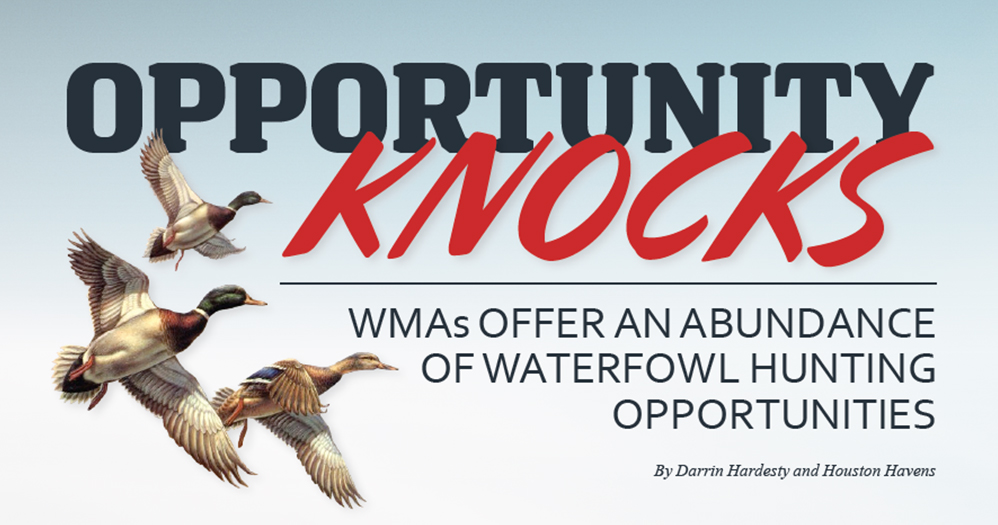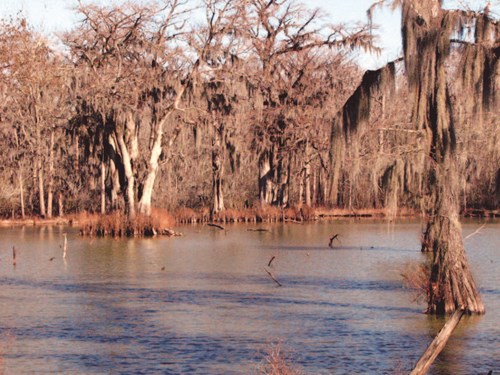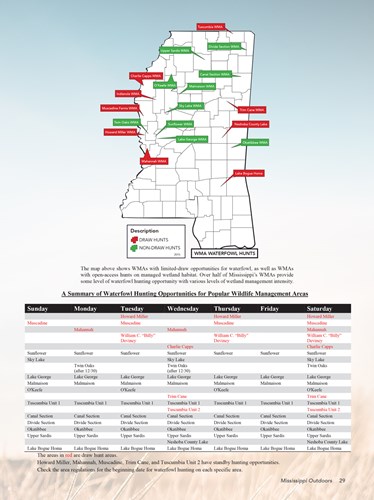Opportunity Knocks
11/30/2018 9:49:48 AM
By Darrin Hardesty and Houston Havens

Waterfowl hunters looking for a place to hunt should take the time to investigate the abundance of diverse, quality waterfowl habitat and public waterfowl hunting opportunities around the state of Mississippi, particularly in the Delta region. The Mississippi Department of Wildlife, Fisheries, and Parks (MDWFP) manages and maintains a diversity of the state’s Wildlife Management Areas (WMAs). More than half of these WMAs provide some form of public waterfowl hunting opportunities on managed wetland habitat.
Depending on the WMA, many options for different styles of hunting are offered: such as walk-in areas, boat-access areas, and ATV trails, providing access to flooded timber, flooded agriculture, and managed moist-soil areas, as well as deeper, open-water habitats. WMAs also provide different types of waterfowl “hunting systems.” Some areas have no restrictions on the number of people allowed to hunt during hunt days. This unrestricted hunt system provides maximum opportunity seven days per week on a first-come, first-served basis for hunters to enjoy whenever their schedules permit. Other WMAs simply restrict the number of days they are available for open-access hunting. In addition, on some areas, MDWFP has made a quality hunting experience a priority through the development of the limited-draw hunting system.
Hunters can freelance waterfowl hunt on many areas such as Sunflower, Malmaison, O’Keefe, Sky Lake, Shipland, Pascagoula, Nanih Waiya, or Canal Section WMAs (among others). Alternatively, if hunters are after a more structured experience with defined hunting units and on-site personnel available for questions, perhaps one of the areas offering a limited access hunting opportunity would be of interest. Howard Miller, Charlie Capps, Mahannah, Trim Cane, Tuscumbia (Unit 2), Pearl River (youth), Muscadine Farms, and William C. (Billy) Deviney WMAs all have limited access waterfowl draw hunts. Hunters apply online for a chance to hunt the WMA of their choice on the date of their choice, and if selected, they will have a reservation to hunt a portion of the WMA on their hunt date. Interested hunters can apply during any of the draw application periods held during fall and winter for regular season duck hunts or during early August for September teal season hunts.
Waterfowl Draw Hunts
The chance of being drawn for a pre-season reservation waterfowl hunt varies from one WMA to the next. Harvest success, word-of-mouth, location, and waterfowl use all help determine how many people apply for a certain WMA. Also, how many dates hunters choose and how they prioritize those dates can influence their chances of being drawn. For example, prioritizing for all available hunt dates within a draw period increases the likelihood of being drawn.
The goals of the draw system are to reduce potential conflicts among hunters, distribute hunting pressure, and sustain waterfowl use on the areas. Hunters may apply for as many WMAs as they wish, and are given the ability to assign priority to the dates they would like to hunt. If selected, applicants are notified of their WMA reservation and hunt date via email, and they are guaranteed a place to hunt the area on that day. On some areas, hunters who were not drawn can still show up on hunt days for the opportunity to fill a position left open by an absent reservation holder.
Special youth waterfowl hunting opportunities are also available on Mississippi WMAs. Trim Cane and Pearl River WMAs have designated youth waterfowl draw hunts available for application on-line each fall. All other WMAs allow open access during the two Youth Waterfowl Hunting Days (usually the Saturday before and the Saturday after the regular waterfowl seasons), where WMAs are open on a first-come, first served basis for youth to have a special opportunity to use the areas. During these days, only youth are allowed to duck hunt, and they must be in the presence of a fully licensed adult. Some of the notable Mississippi WMAs offering waterfowl hunting opportunities:
Charlie Chaps
When migrating ducks are passing through this area of northwest Mississippi, waterfowl hunting can be as good as it gets. Charlie Capps WMA is located in Bolivar County off of State Route 8, 5 miles east of Rosedale. A 5-mile long manmade levee completely encircles 510 acres of some of the most productive moist soil habitat around. The property totals 630 acres, consisting of 6 waterfowl impoundments and a small fishing lake on the east end of the area. Hunters who scout the area well can often find ducks tucked away in the moist soil openings and willows. ATV/UTV trails allow for easy access to all of the impoundments. There are spotted patches of willows and oaks throughout the old swamp bottom providing numerous locations for hunters to hide. Charlie Capps WMA is a draw only WMA, with no standby option.
Willaim C. (Billy) Deviney
Deviney WMA is series of retired catfish production ponds that have been renovated and are now managed for agricultural production and moist soil habitat. For the 2018-2019 season, approximately 940 acres of the WMA were planted in rice and harvested. Due to the nature of a farming lease, there is little hunter cover found inside the hunt units. However, hunter cover can typically be found around the perimeters of ponds along the levees. Successful hunters often use a small layout boat, layout blind with tub, or something similar to allow a reduced silhouette. ATV/UTVs are recommended for easy access, but some hunt units can be accessed by foot. Deviney WMA is also a draw only WMA, with no standby option.
Howard Miller
This 2,400-acre tract located in Issaquena County is a former rice and soybean farm that was acquired by MDWFP in 2007. There are 48 fields separated by levees and ditches. The majority of this area is planted in soybeans (with strips of corn left for hunter cover), and rice. Approximately 480 acres are managed for quality moist-soil habitat. Plant species that are selected for include smartweeds, sprangletop, wild millets, and various sedges. All of these native species produce large numbers of seeds that are relished by waterfowl in winter. Waterfowl hunting is by draw hunt only with a combination of preseason draws and stand-by opportunities. Hunts are conducted on Saturdays, Tuesdays, and Thursdays throughout the waterfowl hunting season.
Mahannah
Mahannah WMA, located in the Delta north of Vicksburg, consists of approximately 12,695 acres of mature bottom-land hardwoods, hardwood reforestation, and moist soil wetland impoundments. This area is part of one of the most ecologically intact and biologically diverse bottomland hardwood ecosystems in the Delta. The area is a unique balance of flooded timber, cypress swamps, and con-trolled flooded waterfowl impoundments. This diverse land provides habitat for some of the Delta’s largest concentrations of wintering waterfowl. Mallards, northern shovelers, canvasbacks, blue-winged teal, green-winged teal, gadwall, northern pintails, wood ducks, wigeon, and other species are often abundant. Extensive wetland habitat improvements were completed on Mahannah WMA recently, providing additional waterfowl hunting areas and allowing better habitat management capabilities in wetland impoundments.

Mahannah WMA
Malmaison
Malmaison WMA is located in Grenada, Carroll and Leflore Counties near Greenwood. This 9,483-acre WMA is as diverse and unique as any other public area in the state. Roughly 800 acres of the WMA lies in the fertile loess hills and the rest in the equally fertile Yalobusha/Mississippi River floodplain. Oxbow lakes, cypress-tupelo swamps, sloughs, and seasonal wetlands are abundant. A spectacular suite of songbirds, birds-of-prey, waterfowl, and wading birds can often be found on the area, seasonally. The Malmaison WMA green-tree reservoir (GTR) area is managed to provide forested, scrub-shrub, and moist soil winter wetland habitat for waterfowl hunting. The GTR also contributes valuable habitat to deer, turkeys, and squirrels during the rest of the year when dry. The McIntyre Scatters area also provides valuable semi-permanent and scrub-shrub wetland habitat for waterfowl hunting during winter when natural water levels are sufficient. Both boating and walk-in access is available for waterfowl hunting on this area.
Muscadine Farms
The 90 retired catfish ponds on this Washington County WMA are intensively managed for waterfowl habitat. Each pond is managed individually, and there are at least three individual ponds per waterfowl hunt unit. The majority of ponds are managed for annual moist-soil vegetation with beneficial native plants. Plant species include smartweed, sprangletop, wild millets, and various sedges. All of these native species produce large numbers of seeds that are relished by waterfowl in winter. Several ponds across the WMA are managed as semi-permanent wetlands, with emergent and floating aquatic plant species providing an additional food source for wintering waterfowl and other wetland wildlife on the area.
O’Keefe
O’Keefe WMA is not only made up of mature bottomland hardwoods, but also has some productive agricultural fields, retired agriculture fields in which hard-wood species were replanted, and managed moist-soil wetland habitat. The agricultural fields are leased annually to a farmer for production farming. Soy-beans and corn are typically planted, and a percentage of standing crops is left in the fields for wintering waterfowl food. O’Keefe WMA also provides a GTR, which is divided into three sections that allow for a three-year flooding rotation. These areas provide flooded bottomland hardwoods, which play an important role in both providing a food source as well as cover for wintering waterfowl. Waterfowl hunting on O’Keefe WMA is open access, and hunting is allowed on Saturdays, Sundays, Tuesdays, and Thursdays throughout the waterfowl hunting season.
Tuscumbia
Consisting of approximately 2,600 acres, Tuscumbia WMA is split into two distinct blocks of land known as Unit 1 (1,400 acres) and Unit 2 (1,200 acres). Unit 1 (the northern portion) includes scrub-shrub, aquatic emergent, and forested wetlands. Hazel alder and button bush comprise most of the shrub cover. Cypress, tupelo gum, and willow are the dominant tree species. Aquatic emergent and moist-soil plants exist in various quantities, providing foraging habitat for waterfowl. Unit 2, to the south, was mostly abandoned agricultural fields before waterfowl impoundments were created in 1998. There are now 10 waterfowl impoundments, ranging from 19 to 83 acres in size that are intensively managed to provide waterfowl habitat. Waterfowl hunting is open access on Unit 1, and Unit 2 is managed under a waterfowl draw hunt.
For more information on waterfowl and other migratory game birds, please contact us by calling (601) 432-2199 or visit www.mdwfp.com/waterfowl.
Darrin Hardesty is a Statewide Waterfowl Program Biologist for MDWFP.
Houston Havens is the Waterfowl Program Coordinator for MDWFP.
(click to enlarge)










